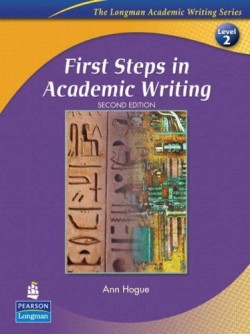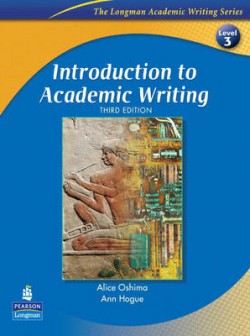Double Review of Academic English Publications: First Steps in Academic Writing and Introduction to Academic Writing
reviewed by Neil Mcbeath, UK
Neil McBeath served as a uniformed Education Officer in the Royal Air Force of Oman from 1981 to 2005. During that time he gained two Masters degrees and the Omani Distinguished Service Medal. Refusing to renew contract in 2005, he taught for two years with BAE Systems in Saudi Arabia. He has now returned to Oman and is teaching at the Sultan Qaboos University. E-mail: neilmcbeath@yahoo.com
First Steps in Academic Writing (Second Edition)
Anne Hogue 02-09-2008
Pearson Longman Pp. 229. ISBN. 9-780132414883

Introduction to Academic Writing (Third Edition)
Alice Oshima and Anne Hogue 2007
Peason Longman PP.221 ISBN 9-780131933958

It is unusual to review second and third editions, but in this instance the coursebooks have been so comprehensively revised that a reassessment is justified.
To be frank, I would not have recommended the original versions of these books. The contained minimal illustration, and were printed on a cheap, possibly recycled, paper that may have been good for the future of the planet, but which resulted in yellowing pages that always looked as if they had been used several times before. Even the book covers manages to lack appeal.
So far as the contents were concerned, First Steps was safe, but rather pedestrian, while Introduction was downright confusing. For some reason best known to themselves, the publishers issued two versions of the second edition, before and after the death of Mother Teresa of Calcutta. In class, this resulted in pair work exercises where students suddenly discovered that they had different texts, and the resulting disruption can be imagined.
Both books, moreover, followed the “This-is-how-you-write-academic-text” rhetorical pedagogy criticised by both Davidson and Spring (2007; 2008) and Palmer (2008). Friedrich (2008) moreover has questioned whether standards of academic discourse acceptability, set by college writing courses in the USA, remain valid in the globalised world of the 21st century.
However we answer that question, the new editions of this course have taken a step in the right direction. There are far more illustrations; both drawings and monochrome photographs. The paper is white, not cream turning yellow, and some of the model passages and practical exercises are now printed on contrasting backgrounds – wisteria (First Steps) and pale blue (Introduction).
First steps has also revised its content – Unit 2 – Writing Instructions, has become Unit 3 – Giving Instructions; while Unit 3 – Describing has become Unit 2 – Describing a Place. I was particularly impressed with Giving Instructions. Having once worked with an American “expert” who informed me that, when working with Omani servicemen, “All you can do is teach them how to change a car wheel, how to make a cup of tea and how to pick their noses”, it was refreshing to find other Americans offering topics like “How to have a successful garage sale” (PP. 67-68); How to get an A/F in English; How to get the job of your dreams (P. 70) and How to drive your teacher crazy; How to wax a car (P. 73).
Even better, however, was the “Teen versus school dress code” article (P. 166) about a boy called Nathan Warnack who was turned away from a high school dance because the school principal did not want “students looking like clowns”. Nathan was wearing a kilt. This passage got my Omani students away from the topic that all Muslim women have the right to cover their hair if they so wish, and onto the more complex question of appropriate contexts for national dress. It also allowed for Google searches, and work well beyond the “opinion essay”.
Sop far as the Introduction is concerned, the revision process has been, if anything, even more thorough. The authors have placed paragraph writing at the centre of the book, only turning to Essay Organisation and Opinion Essays in the last two chapters. Their justification for this is that “rhetorically instruction flows more sequentially from paragraph to essay” (P. ix) although that is really self-evident. My own students seemed to ignore this idea, moving automatically to expand their paragraphs into essays.
At the same time, however, Oshima and Hogue have now closed the gap that existed between prewriting and the final draft, and they have introduced exercises on summary writing. Both these changes reflect the needs of the 21st century. Even when institutions like the Sultan Qaboos University insist that students produce handwritten final drafts, the students themselves have realised that they can save preliminary drafts on computer, altering them as required, and then handwriting the final version. Summarizing, of course, is an essential skill for anyone who conducts internet research but who wishes to avoid plagiarism.
First Steps and Introduction, even in their new editions, are not perfect. They remain heavily influenced by Western culture and the “Styles of Popular Music” model essay in Introduction (Pp. 148-150) manages to assume too much existing knowledge, while simultaneously presenting information that is out of date – Queen Latifah is now famous for playing light comedy roles in movies, not as a female rap artist.
Even so, both books are a considerable improvement on their earlier editions, and they both contain material that university level students can be expected to enjoy. They engage student interest, and they show students how to master new skills, including those that they will require in their life beyond the classroom.
References
Davidson, Peter and Spring, Jerry. (2007) The Myth of Academic Essay Types.
Paper delivered at the 11th CTELT Conference, Dubai, UAE, November 1-2, 2007.
Davidson, Peter and Spring, Jerry. (2008) Rhetorical Patters in Academic Writing;
Re-examining Conventional Wisdom. In Christine Coombe; Adel Jendli and Peter Dasvidson (eds) (2008) Teaching Writing Skills in EFL; Theory, Research and Pedagogy. Dubai; UAE. TESOL Arabia.
Friedrich, Patricia. (2008) “I want to be part of the club” – Raising Awareness of
Bilingualism and Second Language Writing among Monolingual Users of English. In Patricia Friedrich (ed) (2008) Teaching Academic Writing. London Continuum. pp. 177-191.
Palmer, David. (2008) The Myths of Academic Writing. Paper delivered at the 14th
International TESOL Arabia Conference, Dubai, UAE, March 13-15, 2008.

Please check the Teaching Advanced Students course at Pilgrims website.
Please check the CLIL - Teaching Other Subject Through English course at Pilgrims website.


|